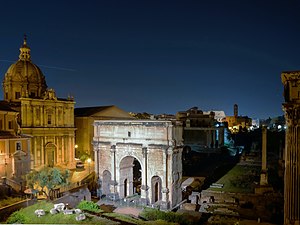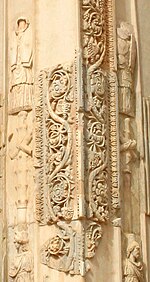

You can help expand this article with text translated from the corresponding article in Italian. (December 2008) Click [show] for important translation instructions.
|topic= will aid in categorization.Content in this edit is translated from the existing Italian Wikipedia article at [[:it:Arte severiana]]; see its history for attribution.{{Translated|it|Arte severiana}} to the talk page. |
This article includes a list of general references, but it lacks sufficient corresponding inline citations. Please help to improve this article by introducing more precise citations. (March 2020) (Learn how and when to remove this message)
|

Severan art is art production by the Roman Empire under the Severan dynasty, usually taken as running from 193 to 235, through the emperors Septimius Severus, Caracalla, Heliogabalus and Alexander Severus. Official Roman art of the military anarchy which followed, ending in 253 with Gallienus, has no character of its own and so can be seen as a continuation of Severan art, and so that art can be seen as running for the whole first half of the 3rd century.[citation needed]
In this period began the process that ended in the rupture between Roman art and that of Late Antiquity, the watershed between classical art and that of Byzantium and the Middle Ages.[citation needed] Some of Severan art's products saw the emergence of obvious elements from plebeian art and provincial art, whilst in other areas traditionally Hellenistic elements were kept alive longer, such as in portraiture, which flourished in this period with masterpieces of great psychological depth.[citation needed]
This section is empty. You can help by adding to it. (July 2010)
|


The most important works in Severan art were the Arch of Septimus Severus in the Roman Forum (erected for the Parthian triumph of 203); the Forum, the basilica and the Arch of Leptis Magna, the birthplace of the emperor (completed by 216); and the Arcus Argentariorum in Rome, erected in honor of the emperor by the bankers of the Forum Boarium in 204.
This section is empty. You can help by adding to it. (January 2011)
|
This section is empty. You can help by adding to it. (January 2011)
|
The Roman portrait in the third century was one of the most significant art forms of the period. The artists, now free from the constraints linked to the Hellenistic tradition, implemented expressive characteristics into physiognomic portraits in marble and bronze.[citation needed] From this new style of portrait one could infer the socio-economic situation, and the difficulties of life faced by farmers soldiers.[citation needed]
The imperial portraits are fundamental, from which the main artistic currents of the time can be outlined. The chronology of the most important works is:
Also important are some portraits of empresses, including that of the influential Julia Domna, wife of Septimius Severus and patron of Syrian artists in Rome, and that of Sallustia Orbiana, wife of Severus Alexander.
Typical of the time is the "engraving" process, with small superficial chisel strokes that draw the short hair and the hair of the beard, which was neither fashionable nor shaved, but kept short with scissors. These technical devices were frequent in Rome, though less often seen in the eastern provinces.[citation needed]

Monumental sarcophagi are also very representative of the artistic methods in use during the period. In Rome, there are various specimens imported from Asia Minor, while works of Roman manufacture were exported to the western provinces. One of the best known works of this period is the Ludovisi Battle sarcophagus, where the figure of the young commander on horseback was recognized as Hostilian.[citation needed] Typical is the production of sarcophagi with lion hunting scenes, datable between 220 and 270, added to the recent stoic concept of life as a militia.[citation needed] Other types are instead linked to the Cult of Dionysus adorned with symbolism that alludes to regeneration after death, just crushed grapes or wine.[citation needed]
Indicative of the moral thinking of individuals of the time are sarcophagi where the deceased are depicted as philosophers or muses. From these representations, born in a context strongly anchored to paganism, evolved the typologies of crypto-Christian sarcophagi of the end of the third century.[citation needed] Figures representing Christ and the apostles were depicted.
This section is empty. You can help by adding to it. (July 2010)
|

In Rome, in the wake of the fire of 191, Septimius Severus instituted a new phase of construction: the Temple of Peace, the Horrea Piperiana, and the Porticus Octaviae were rebuilt; a wing was added to the imperial palace on the Palatine Hill, with a new monumental facade towards the Via Appia; and the Septizodium, the arch of Septimius Severus and the Baths of Caracalla were raised. It is likely that the Temple of Serapis was rebuilt by the Severans.
There are few remaining paintings from the period, and dates can only hypothesized. The best studied examples are the Fayum mummy portraits, dated from the late 1st century BC or the early 1st century AD onwards. It is not clear when their production ended, but recent research suggests the middle of the 3rd century.
|
Roman art topics
| |
|---|---|
| Roman art periods |
|
| Types |
|
| Related topics |
|
| Art in related cultures |
|